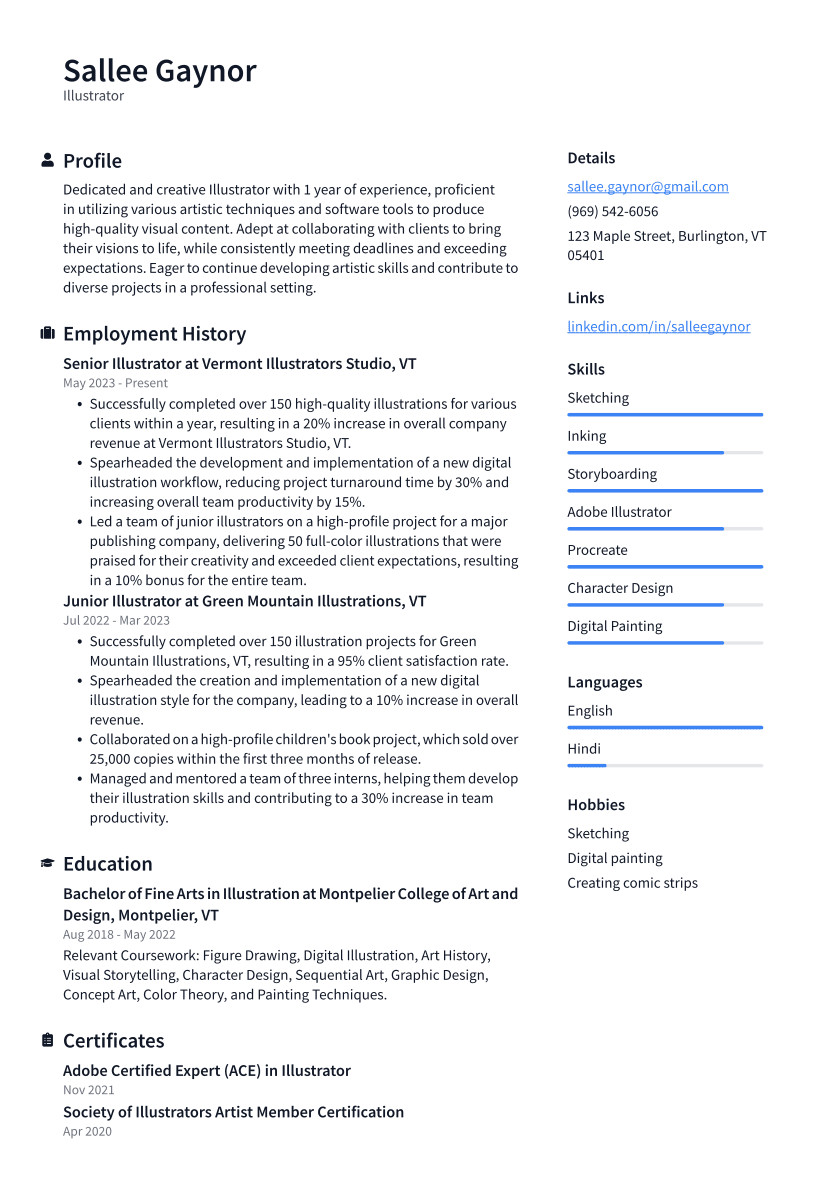Illustrator Resume Examples
Writing a great illustrator resume is important because it is one of the first things a potential employer will see when they are considering you for a position. It is your opportunity to make a good first impression and sell yourself as the best candidate for the job.
Create your resume
Select from 7 professional resume templates
If you're looking for inspiration when it comes to drafting your own illustrator resume, look no further than the samples below. These resumes will help you highlight your experience and qualifications in the most effective way possible, giving you the best chance of landing the illustrator job you're after.
Essential Components of an Illustrator's Resume
An Illustrator's resume is a critical document that showcases their skills, experience, and artistic style to potential employers. It requires thoughtful composition to stand out in the competitive art industry. The resume should highlight the illustrator's technical prowess as well as their creative vision. This guide will delve into the key sections of an Illustrator's resume, discussing their importance and content, and providing tips to make each section engaging for hiring managers.
1. Contact Information
Begin your resume with your Contact Information, ensuring it's accurate, up-to-date, and prominently placed. Include your full name, phone number, and a professional email address. Consider adding your LinkedIn profile and the URL to your online portfolio to showcase your work.

Avoid sharing excessive personal details like marital status or age to maintain privacy and prevent potential biases.
2. Professional Summary or Objective Statement
The Professional Summary or Objective Statement is a brief pitch that outlines your skills, experience, and career goals. Tailor this section to each job application, ensuring it aligns with the job description.
- Artistic talents
- Technical abilities
- Field experience
- Kinds of projects done
- Skill with design tools
- Special achievements or awards
Your Career Growth Goals:
- Entry-level positions to build your portfolio
- Senior roles in established design firms
Related: Top Illustrator Resume Objective Examples
3. Skills and Proficiencies
List your relevant Skills and Proficiencies, including technical, artistic, soft skills, industry knowledge, and certifications. Ensure these skills match the job description and highlight your unique strengths.
Related: Illustrator Skills: Definition and Examples
4. Work Experience
Detail your Work Experience with job titles, employers, dates, and responsibilities. Use action verbs and quantify achievements where possible. Group freelance or contract work under a single title to maintain clarity.
5. Portfolio or Samples of Work
A strong portfolio is essential. Include diverse and consistent work samples that reflect your style and skills. Provide a link to an online portfolio or integrate samples into your resume if the format allows.
6. Education and Certifications
Detail your Education and Certifications, emphasizing relevant degrees, courses, and professional certificates. Highlight any additional workshops or seminars attended.
Related: Illustrator Certifications
7. Awards and Achievements
Include any Awards and Achievements that recognize your work, providing details about the award and the reason for receiving it. Mention significant projects or collaborations with notable clients.
Remember, honesty is paramount; ensure all information is verifiable. If you're new to the field, focus on showcasing your skills through a robust portfolio.
